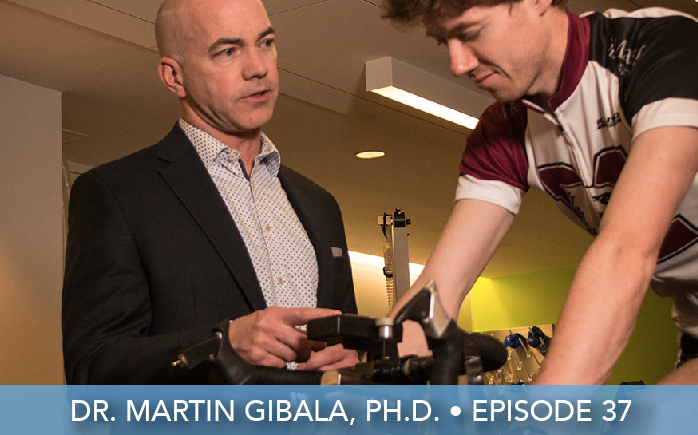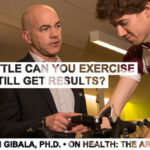Episode 37 | Dr. Martin Gibala, Ph.D. | Exercise Snacking

CLICK PLAY!
FAMILIAR WITH PODCASTS? LISTEN ON iTUNES!
Follow Along With The Transcript!
Kathy Smith:Hi Martin. Welcome to the show–or back, I should say.
Martin Gibala: Hey, Kathy. Thanks for having me on again.
Kathy Smith: Ok, so, let’s get right into it. How low can you go? In other words, like, we’ve been doing intervals now for years, and the focus of your research was really get into a little bit more of what is the least amount of time that you can do intervals and achieve results? Can you tell us what you found out?
Martin Gibala: Sure, the book title is a bit of a teaser headline, but it comes from research that we’ve been doing in the lab where we had people do three 20 second bursts of exercise. So, that’s the one minute. Now, that’s typically set within a time commitment of 10 minutes. So, there’s a bit of a warm up, a bit of a cool down and some recovery in between those hard intervals, but essentially the workout involves one minute of very vigorous exercise. We’ve done a number of studies, different permutations now showing that can be an extremely time efficient way to boost fitness.
Kathy Smith: Well, it’s interesting. Since the last time we talked, I have started a program where–it’s a biking program, and I’m preparing for my bike ride across America. Part of the program is where you go in–and it’s Dr. Max Testa here in Park City that leads the program. You get different zones, and the zones are determined by you get on the bike, and as you’re riding, they prick your ear and take a little bit of blood along the way. They create these zones to find out–really it’s about your lactate threshold.
What I found and what I want to talk to the audience about is with all the training I do, I swear that within the last two or three months–it’s been about three months now–I cannot believe the difference in my aerobic capacity, in my endurance, in my fitness level through this type of training. So, one of the things I think I want you to explain to me and, also, the audience is what’s happening when I’m going through these push zones of–for the audience, again, what I’m doing is five zones – the fifth zone being the hardest. Obviously, it’s progressive.
As you start the routine through the course of the week–I’m doing three trainings a week. On one day a week, we’re pushing to a place that when you leave and when you’re done for that zone five, you’re wanting recovery. So, you’re really, really pushing. What’s happening inside my body when I do that kind of workout compared to when I just get on my bike and I ride for an hour?
Martin Gibala: Yeah, a couple of ways to address that I think. I’m a muscle physiologist, as you know. I’m interested in these cellular and molecular changes that take place in muscle. And, so, on the one hand, the way to think of it is, you can trigger the same basic remodeling process in different ways.
So, the traditional approach would be to sort of step on the gas pedal at a moderate pace and hold it there. What happens, of course, is the fuel sensors in the muscle go down over time. So, the fuel gauge is deplete, so things like muscle glycogen and that goes down and the body responds to the drop in the fuel and generates processes, stimulates M, R and A, and changes in proteins that allow the muscle to remodel. What we’ve shown in our lab is that you can basically trigger that same molecular remodeling process in a different way, and that’s by stepping on the pedal very hard, dropping the fuel gauges much more quickly, and that allows for a more time-efficient strategy to induce essentially the same benefits.
What you’re talking about is essentially combining those. So, zone training is just that. There’s three-zone training, five-zone, seven-zone, but it’s really this concept that periodized training and trying to hit the body in different ways. So, when you challenge this system in different ways like that, you can have almost like an additive effect. Clearly, there’s some element as well of muscle fiber type being involved. We have these larger type two muscle fibers that often are not called upon, certainly in everyday living and even when we just do moderate, continuous training. So, when we do these very short, hard bursts of exercise, we’re definitely recruiting all of these muscle fibers and they respond to training.
So, I’ll often use the analogy of there’s the apples to oranges comparison, and that’s where you compare a small dose of intervals versus a much larger volume of endurance exercise. We see that those two approaches can elicit very similar adaptations even though the time required for the intervals is shorter.
Then, there’s the apples to apples comparison and that’s where you take a given volume of exercise. In the one, you include this high intensity intervals and when you do it with that strategy, you optimize the overall effect so the adaptation is superior with the intervals. Of course, elite endurance athletes have known this for well over 100 years. There were Finnish Olympians near the turn of the century winning Olympic gold in middle distance races, training almost exclusively or largely using these short, hard intervals.
Kathy Smith: So, you mentioned athletic performance and how people have been using intervals. It’s interesting. Intervals have been around for a long time, and you mention in your book that in the 1950s the Royal Canadian Air Force incorporated it into their military training and it became, again, popular outside of the military. Through the years, we have had interval and interval training.
As a matter of fact, my first interval workout–video workout that I did that was something that I shot in the 80s–it was based on functional training and interval work. It sort of morphed and we’ve learned more about it through the years and, yet, I find that you have the people that will step in and try interval training. Other people kind of shy away because they think it’s too hard, too intense and, hey, if I can get the same benefit with going for my 45-minute moderate walk, why do I want to push myself? Is there anything you want to say to those folks?
Martin Gibala: Sure. I think if you’re already being active, good on you, because you would well know, the biggest problem we have is just getting people moving to begin with. So, if you’re already active, that’s well over half the battle. What I would suggest, though, is that for some people if they don’t have 45 minutes or that big block of time in the day, they’ll tend to blow off exercise and they’ll think, “Ah, it’s just not worth it.” I think intervals, we like to say, provide a more convenient way to fit exercise within your life rather than having to structure your life around exercise. I do think, as well, this concept of intensity trumping duration, that’s quite relevant. So, we need to push this system a little bit sometimes. We need to step on the gas, we need to get outside of our comfort zone now and then in order to continually improve.
So, certainly, we’re not setting this up as an us versus them argument or intervals versus the traditional approach because the public health guidelines are, of course, based on really good science, but a lot of people aren’t listening. So, a big lesson, I think, from interval training research and hopefully some of our own work is finding more time-efficient options for people given that time or a lack of it is the main sited barrier for lack of physical activity. So, if we can provide some more menu choices, more options for people to choose from, we think that’s a good strategy.
Kathy Smith: So, when you get home from work and you have all of the responsibilities that people have when they get home, instead of blowing off your workout because you don’t have 45 minutes, what you’re saying is get out and do the 10-minute, 15-minute, whatever and pack a little bit more into less time and you’re still going to be getting those benefits, which is a great message.
Martin Gibala: Absolutely. We’ve even just recently done a study with stair climbing, showing that the one minute workout works on stairs. A lot of us live in office towers–or sorry–live in apartment complexes or work in office towers and, so, the stairs are really a convenient option in order to incorporate this through the day. Again, getting back to this idea of exercise snacking, we’re learning that you can sprinkle physical activity through the day and maybe it’s even actually a superior approach than a single, long block of continuous exercise at a given time.
Kathy Smith: I like that – exercise snacking with some sprinkles. I’ll take them both. A little motivation. So, when it comes to intervals and this type of training, what’s happening on the cellular level? Because one of the things that there’s been a lot of talk now recently about is if you keep your cells well, then, you’re going to stay younger longer. There’s a lot of discussion talking about the cells and what goes on within the cell and how you need to stimulate your body on the cellular level and how that relates to longevity, and I’m wondering if you have any thoughts on that.
Martin Gibala: Yeah. Well, again, I can speak to muscle because that’s my main area of expertise. We know that, for example, mitochondrial content in muscle. So, people have a good sense of what cardio health is, this idea of the health of the cardiovascular system to deliver blood and oxygen and pump that through the body.
But muscle health is equally important, and one of the main contributors to muscle health is the content of mitochondria. Mitochondria are these organelles that suck in oxygen in order to burn fuels like sugars and fats, and that helps with, you know, trying to prevent type 2 diabetes and a lot of other cardiovascular and other disorders, but the muscles play a big role there. So, one of our interests has been looking at the cellular level, the signals that lead to what we call mitochondrial biogenesis or how we create additional mitochondria inside of our cells, and we’ve shown that these very short interval workouts can be very beneficial there.
My colleague, Mark Tarnopolsky, has done a lot of fascinating research showing how exercise can affect a whole host of different tissues. A lot of this work is in animals, but they’ve used an aging mouse model. So, basically, these mice get old very, very quickly, and their mitochondria get worse and lots of other cells in the body deteriorate very fast. Mark has shown just by exercising these animals, you can virtually eliminate these adverse effects. So, Mark is very interested in trying to identify some of these systemic factors that, for example, cause your skin to be better or your gonads to be better when you exercise, so there’s a lot of interest now in these what are called exerkines–basically, these molecules that are stimulated by exercise, released into the bloodstream and can circulate to exert benefits in other tissues including the brain, of course. There’s a whole host of physiological systems that benefit from exercise, not just muscle.
Kathy Smith: Well, getting back just to the basics for burst training and for people who haven’t done it before, what I think was interesting in you book is you talked about this high level. We talk about burst and we say, “You’re going at a high intensity,” but, then, how do you define high intensity. A lot of times, we’ve used heart rate and there’s been something through the years that we take 220 minus your age and we call that your maximum heartrate. Then, there’s certain percentages of that. Typically, when you get into the training zones, your taking 70 and 80 and, then, your intervals you’re taking, let’s say, 80% of that.
What I found–I thought this was great, because I’ve always been sort of anti the heartrate, because I would look at the monitors and would never quite sync up to where I thought I was at, at that particular point. So, you talk about this way of determining if you’re working out hard enough in the burst part of your training. You say, “Think about how fast you would run,” – let’s say you were running – “how fast you would run if you had to grab a child,” – you know, there’s a car screaming down the highway and there’s a child there, you had to run and grab that child, that’s what your burst should feel like.
So, explain how this idea of how we perceive how hard we go during the burst and how we monitor that.
Martin Gibala: Yeah, heartrate training gets back to zone training a little bit. It can be very effective. But you’re right. You raise the point that we elude to in the book, and that’s the fact that, especially when you’re doing short, very vigorous exercise, heartrate sort of lags intensity. Most of us couldn’t imagine an effort that would be greater than what I call sprint-from-danger pace or that save your child from an oncoming car. Let’s say you had to run half a block.
If you did that, the effort’s about as hard as you can imagine or the drive to run fast is about as high as you can imagine. But if we measured your heartrate after that half a block, it might be up to about 75 or 80% of maximum; although, you’ve exerted yourself very hard.
So, this brings up the idea of anchoring things back to perceived exertion and we borrow some – or we play on – some great work that was done by an individual named Borg. Some of your listeners might be familiar with the Borg scale. There’s different scales, but a very simple one is a zero to ten scale, where one is about as easy as it gets and 10 or 10 plus is that all out sprint from danger pace and anchoring efforts relative to that scale.
So, interval walking, for example, might be a three out of 10, and the more intense you go, obviously, the higher the number. So, when we’re talking about these very short, very hard sprints, we’re asking people, try and give us a 10, but there’s a whole range in between there. If there’s a point, I’d really like to stress, it’s that a one minute-workout is a very effective protocol, but it’s extremely demanding and certainly not for everyone.
So, there’s a whole range of interval-type exercise that has been scaled to almost any starting level of fitness including interval walking, which we call the beginner and that’s maybe a three out of 10. There’s research in Norway that’s used for four-minute efforts that demands an effort of about six or seven on that 10-point scale but, again, there’s a sliding scale there between intensity and duration and generally, the higher the intensity, the higher the perceived number on that 10-point scale, the lower the duration of exercise that you would need to do and still reap benefits.
Kathy Smith: Ok. So, what you’re saying is that no matter what your age or your fitness level that you can do intervals. But we always have to caution people to check with your doctor before starting any exercise program. In general, what you’re saying, this isn’t just for elite athletes. I think we talk about fitness levels but also age. I think that people think that if they’re at a certain age, it’s too late to start something like an interval program, but with your walking program, you say just about anybody can start.
Martin Gibala: Absolutely. There’s been work looking at people who have type 2 diabetes in, at least, their mid to late 60s, and there’s interval research on people older than that. In the individuals with type 2 diabetes, they were looking a comparing interval walking, so just picking up the pace a little bit and, then, backing off. They show that after several months, interval walking was better at boosting fitness, improving blood sugar control and even reducing body fat in these individuals with type 2 diabetes as compared to continuous steady-state walking.
So, the take-home message there is even if your only exercise is walking around the block, picking up the pace slightly for a couple of lamp posts and, then, backing off, as simple as that sounds, that can be a very effective strategy.
Kathy Smith: Plus, I find it so much less boring. That’s my thing. I’m so much into intervals now that it’s hard for me to train without intervals because it just breaks things up, just like you said. If I’m out for a walk, I give myself a challenge of, ok, I’m going to go fast until that stop sign up there or to the next tree or something. And if I don’t have that to sort of motivate me, I can get a little bored with the whole thing. So, that’s kind of another benefit.
Martin Gibala: The behavioral aspect is really interesting and, boy, if you want to set a cat within a henhouse, it’s talk about interval training for public health and things like perceived enjoyment in that. On the one hand, you would have what I would call the traditional school of thought and that’s if people do more intense exercise, it’s perceived as aversive, it’s uncomfortable and they tend not to want to do it and, so, that line of thinking would suggest this is never going to be a viable public health strategy.
On the other hand, you have a whole what I call a new age of exercise and health psychologists who are saying, “Wait a minute! Continuous, vigorous exercise is not at all like intermittent vigorous exercise.” There’s a lot of emerging research to show that many people actually prefer this style of training. They enjoy it more. I get back to this idea, I don’t have a lot of time for trying to set it up as an us versus them argument or the traditional cardio approach versus intervals. When I talk to my behavioral colleagues, they say, “Look, the more menu choices, the better. The more exercise options, the better.”
Even I don’t do interval training all of the time. Clearly, I’m a big proponent of it. I still like to go for a walk in the woods with my dog, but I’m like you when it comes to cardio style training, and most of my indoor training in long Canadian winters is on the bike. I detest getting on a bike, sitting at a constant pace and going at that same steady-state rate. So, for me, it’s all about interval training, because for me, I enjoy it but I appreciate that approach is not for everyone.
Kathy Smith: Yeah, and what I like what you said there is about the menu, and that’s always been a huge message of mine, which is start to take a little from the yoga world, from the Pilates world, from the cardio fitness, aerobic fitness, from strength training. This is another tool, but it’s a really important tool.
I think that is, once you read the book and you see the science behind it–but, then, when you feel it, I think that’s–I think science is great and, obviously, I admire you. I adore what you’re doing and stuff, but what I’ve also, through the years, have really gone on gut and cause and effect. Try something for a month, try something for two months, then you see. Like, I see the difference in my legs, because when I’m on a bike and I’m going at that high intensity, it becomes more of a resistance training as well as an aerobic training. I’m using those legs much more powerfully than if I wasn’t being pushed.
I had one of these workouts yesterday. What happens is that I get off the bike and I have my two days of recovery, but I’m feeling muscles in my hamstrings, in my butt that I didn’t feel before when I was just biking normally. So, that’s kind of the fun part of it. Then, I wait two days, I have another kind of training program and through the course of a month, two months, I notice my legs getting stronger and stronger. So, when I go back and I retest, I’ve gained and my fitness level has improved. I think that’s the thing that I find–I mean, science yes, and your book is all based on science obviously, and all of your work is based on science. But just empirically, going out and trying something like this and seeing the results is pretty dramatic.
Martin Gibala: Agreed. I teach a fourth-year elective course called The Integrative Physiology of Human Performance and barring any medical reason why a student couldn’t do this, I insist that all the students do a VO2 max test, and they do what we call a Wingate test, which is one of these 30 second all-out efforts, because I think it’s important to understand and feel what a VO2 max of 50 feels like or what a power output of 500 watts feels like.
You’re right. There’s nothing like actually feeling it to put it into context. When it comes to strength building, the nice thing about intervals is it can be applied in a body weight style training method as well. So, this is the beauty of the approach.
Kathy Smith: Ok, well, thanks for coming back to the show. We could go on and on. I’ve said this before, and it sounds kind of trite, but you’ve heard the difference between try and triumph. The difference between it is there’s a little umph in there. So, the take-away from here is Dr. Gibala’s research is that we should put a little more umph or burst into our workouts. You should try pushing yourself with maybe some sprint training or short bursts and just see how it feels, and you definitely should pick up his book, The One-Minute Workout.
Because if you’ve had any doubts about the science behind it, the impact of interval training, as I said in the entry, you’re going to be blown away with how well researched and how once again, I know you don’t like it, but how you have become the guru of interval training and how everybody should just start incorporating a little bit into their workouts every single week.
Thank you so much, Martin, for being here. I look forward to our next talk.
Martin Gibala: I really appreciate the opportunity to be back, Kathy.
Kathy Smith: Thank you.









